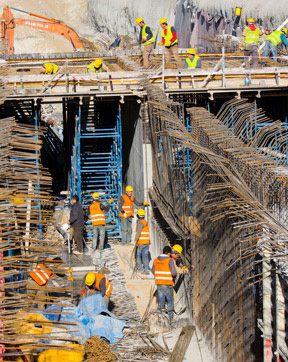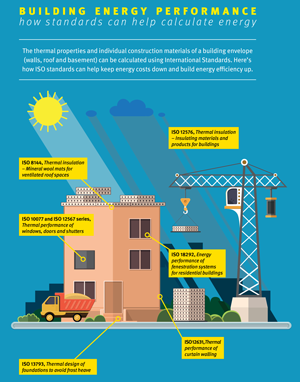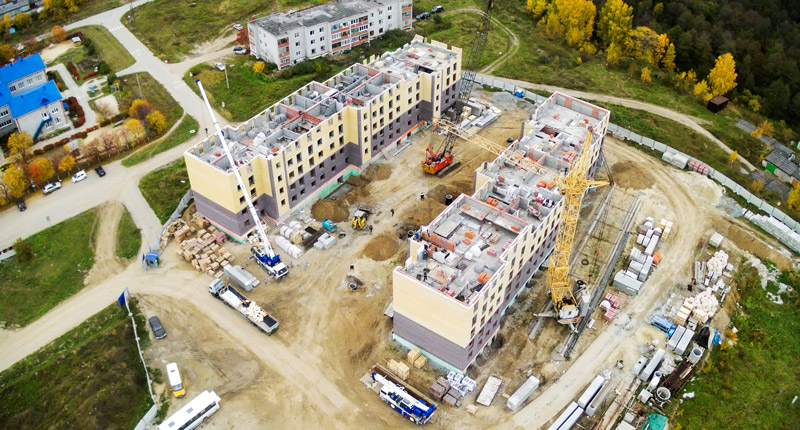Do you know how much electricity your home uses each year? And what about the carbon footprint of your office building? Although many people have a rough idea of how much they spend on fuel bills, they donʼt often know how much energy they use to power their home (namely for heating, hot water and lighting) – in short, their homeʼs carbon footprint. Which is surprising, because itʼs the first question to ask yourself if you want to lower the price of your energy bills.
These days, most of us are aware that we need to cut down on our energy consumption with more energy-efficient homes. In fact, A-rated appliances and sound energy conservation strategies can help save money and energy at home. Depending on your budget, plenty of options exist to cut costs – from minor tweaks to major renovations. By applying a range of techniques in the home – some involving just minor adjustments – you can achieve significant savings in energy costs and carbon.
So just imagine all the houses and commercial and public buildings around the world put together. What does this mean in concrete terms? Surprising (or frightening) as it may sound, buildings consume one-third of energy use worldwide and are an equally important source of carbon dioxide emissions, according to the International Energy Agency (IEA) report Transition to Sustainable Buildings. Whatʼs more, if no action is taken to improve energy efficiency in the building sector, energy demand is expected to rise by 50 % by 2050, says the IEA report. Unless we are deliberate in the way we design, construct and renovate buildings, we could “lock in” our cities to inefficient energy use for decades to come.
Action is needed now, not just because of energy trends but also because buildings are a low-replacement industry. It will not be enough merely to act on new buildings. Improving the performance of our existing building stock is incredibly important.
Decarbonizing buildings

Consider this. According to the Intergovernmental Panel on Climate Change (IPCC), “over the whole building stock, the largest portion of carbon savings by 2030 is in retrofitting existing buildings and replacing energy-using equipment”, and energy savings of 50 % to 75 % can be achieved in commercial buildings that make smart use of energy efficiency measures.
One of the big differences between new and existing buildings is that during the predesign phase of remodels and retrofits, the existing building structure needs to be studied in detail and will introduce a whole set of design constraints. The same design strategies will apply to both, but designers will not have as much latitude to reshape existing buildings.
ISOfocus asked industry experts for their perspectives on these issues and what really needs to be done to improve energy efficiency and ensure that the buildings we build or retrofit contribute to reducing their impact on energy bills, air pollution and carbon emissions – and how ISO standards can help.
The Research Institute for Thermal Insulation (FIW) is one of several leading research and testing institutes for thermal insulation in Germany, with an international sphere of activity. These cover, for example, laboratory investigations, outdoor tests, in situ demonstrations, studies, advanced training and standardization.
Andreas Holm, Head of FIW and Chair of ISO/TC 163, Thermal performance and energy use in the built environment, subcommittee SC 1, Test and measurement methods, explains that for Germany, like many other European countries, one of the major challenges is adjusting existing buildings to become more efficient. “Many new buildings are built as ‘net zero’ energy, but to make an appreciable impact on overall energy consumption, we need to improve the energy efficiency of existing buildings to fit todayʼs standards.” For Holm, the rate at which old buildings are being retrofitted is too slow, about 1 % in much of Central Europe, meaning that it would take a hundred years to work through the stock of buildings we already have.
In most regions of the world, heating and cooling loads represent the largest building-sector energy end-use. Holm says that in most cases, energy is lost through the building envelope – the boundary between the conditioned interior of the building and the outdoors. Retrofitting older buildings can significantly reduce the energy needed to heat and cool them – the only path toward substantially diminishing the energy footprint of the existing building stock.
For example, the energy performance of buildings can be calculated using ISO 16346:2013, Energy performance of buildings – Assessment of overall energy performance. Complementing it are several other ISO standards that can be used to calculate the thermal properties of the building envelope (walls, roof and basement) and of the individual construction materials. These provide the reference for expressing performance in trade documents and building regulations all over the world.
Holm asserts that while the construction sector has historically been quite a national sector, it is gradually becoming more international. “Building suppliers are increasingly operating in different countries, and suppliers and constructors are also much more international themselves now,” he says.

With national governments coming under increasing pressure to maintain low carbon levels, it is encouraging to note that International Standards are being developed, Holm says. “We need this because, overall, the world is becoming more international and this includes the construction sector as well. Multiple standards are difficult to cope with; if you do a calculation with one standard or another, your result may not be the same.”
Furthermore, he adds, “standards reduce cost, make our buildings environmentally friendly and increase the comfort inside our buildings”. By cutting energy bills and retrofitting costs, they guarantee a healthier, more energy-efficient environment and increase peopleʼs well-being.
Constructing sustainably
The Institute of International Harmonization for Building and Housing (IIBH) plays a critical role in efforts to support the development of the building and housing sector in Japan, not only through international harmonization of engineering, system, standards, and codes, but also through international exchange actions such as research and support.
Japan is already one of the worldʼs most energy-efficient countries thanks to efforts by the government and private companies. These days, the country has cutting carbon in its sights. The big challenge, says Nishino Kanako of the IIBH, is to outline the key actions required to transform how buildings are constructed. While transparent and scientific knowledge will offer improved performance and greater economic viability, Nishino recognizes that “there has not yet been such a situation in any part of the world”.
She acknowledges that much more can be done to aggressively pursue effective building codes and deep renovation programmes. “For strict policies, it is indispensable for society to obtain credible, reliable and effective tools for evaluating real building energy performance, which are supported by standards.”
According to Nishino, harmonization between national and international standards is critical. “The development of standards or any other tools should be reflected in International Standards. This is why IIBH is involved in International Standards development,” she says.
Cutting-edge solutions

Of course, any conversation on energy-efficient buildings has to include a discussion on new innovations and methods. For example, the role of energy simulation tools is a big issue for the Norwegian Home Buildersʼ Association.
According to Lars Myhre, the Associationʼs Technical Director and Chair of ISO/TC 163, Thermal performance and energy use in the built environment, subcommittee SC 2, Calculation methods, energy simulation software tools that engineers, architects and researchers use to model energy consumption are key. “I see a big potential for using information from building information models (BIM) in the energy simulations – for heating, cooling, ventilation, lighting, and plug and process loads – and water use in buildings. In Norway, we have started using BIM when simulating the energy performance of residential homes which is very promising. Personally, I am looking forward to using the new standards being developed by ISO/TC 163/SC 2 to calculate and assess the energy performance of new ‘nearly zeroʼ buildings.”
Myhre believes it is imperative that we act now. “To avoid dangerous climate change, it is absolutely urgent to improve energy efficiency and reduce emissions of climate gases. The Paris agreement at COP21 confirms this urgency.”
He, too, goes on to say that standards can make a significant contribution. “Standards are crucial as they give a comprehensive and common framework for calculating the energy performance of single components as well as whole buildings. Using the standards, it is possible to assess alternative measures to improve the energy performance of all types of buildings.”
Going holistic
Helping to decarbonize the building sector is the goal of the new holistic approach being developed by the ISO joint working group on the energy performance of buildings (EPB) co-convened by Dick van Dijk and Prof. Essam E. Khalil. For them, it all comes down to the comprehensive method of assessing energy performance as the total energy used for heating, cooling, lighting, ventilation, domestic hot water and, in some cases, appliances.
Van Dijk and Khalil explain that, with the ISO 52000 series of standards under development, the building industry is expected to be much better positioned to attain energy efficiency improvements with the best available technology and practice. They say that “the ISO 52000 series of standards will enable us to assess the overall energy performance of a building. This means that any combination of technologies can be used to reach the intended energy performance level, at the lowest cost”.
The ISO 52000 series, which is expected to be published in the first half of 2017, is being developed in close collaboration with the European Committee for Standardization (CEN) and other standards organizations. In Europe, the EPB standards are being developed to support national implementation of the Energy Performance of Buildings Directive (EPBD).
Differences in national and regional climate, culture and building traditions, as well as policy and legal frameworks, are taken into account by the EPB series, explain van Dijk and Khalil. “Different options are given for procedures, input data and boundary conditions. For each option, a clear template is provided that can be used to tailor the energy performance assessment to a specific situation. An informative (‘default’) set of choices is also suggested.”
Van Dijk and Khalil explain that the holistic approach is a promising one. “Countries using the approach for several years – take, for instance, the Netherlands – have experienced large-scale implementation and cost savings on a variety of new technologies,” they enthuse. This includes thermal insulation concepts, windows, heating, cooling, lighting, ventilation or domestic hot-water systems, building automation and control, and renewable energy sources.

For today and beyond
If there is an upside with the worldʼs rabid consumption of housing, it is the potential to quickly turn sustainable buildings into a sustainable business. Improving energy efficiency in buildings will not only provide a significant contribution to stalling the rise in global temperatures, but is also a business opportunity for growth. This includes social and economic factors such as creating jobs, improving health and productivity, improving utility capacity management, and reducing pressure on public budgets.
Macroeconomists have stated that energy efficiency is the surest energy supply that exists. According to the IEA report, Capturing the Multiple Benefits of Energy Efficiency, harnessing economically viable energy efficiency investments would facilitate a more efficient allocation of resources across the global economy, with the potential to boost cumulative economic output through 2035 by USD 18 trillion – larger than the current size of the economies of North America combined.
Of course, with climate change looming large, there are challenges ahead. However, van Dijk and Khalil believe that clear and consistent policy targets play an important role in driving innovation in the building sector. “International Standards will be needed to harmonize the terms, definitions, assessment procedures and indicators in order to develop new concepts and technologies as well as monitor and evaluate progress.”
Every step that is taken to reduce environmental impact throughout a buildingʼs life cycle – particularly International Standards – is a step in the right direction. For in the words of philosopher Henry David Thoreau: “What good is a house, if you havenʼt got a tolerable planet to put it on?”
Why energy efficiency?
Energy efficiency has become a pillar of the new United Nations Sustainable Development Goals (SDGs). The SDGs recognize the cross-cutting importance of buildings and cities in achieving global objectives related to sustainable energy and infrastructure. Better buildings can also make significant contributions to addressing climate change, one of the other SDGs, a point that is further acknowledged in the more than 45 new national climate plans that include building efficiency components. In recognition of the important role it must play in ensuring that countries meet their emissions reduction obligations, last yearʼs UNFCCC Conference of the Parties (COP21) in Paris dedicated an entire day to the building sector. This event concluded with the launch of the Global Alliance for Buildings and Construction, an alliance of organizations collectively committed to ensuring that the global building sector will follow the “below 2 °C path”.

